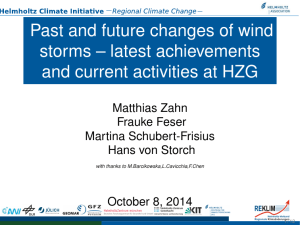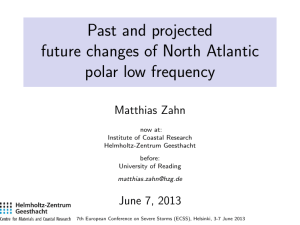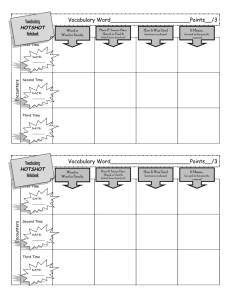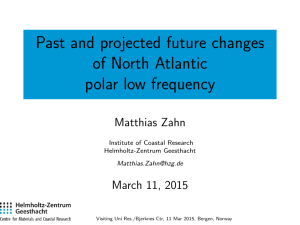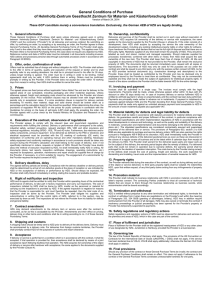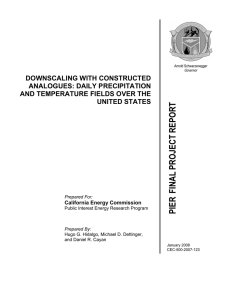Wind storm research at the HZG -
advertisement
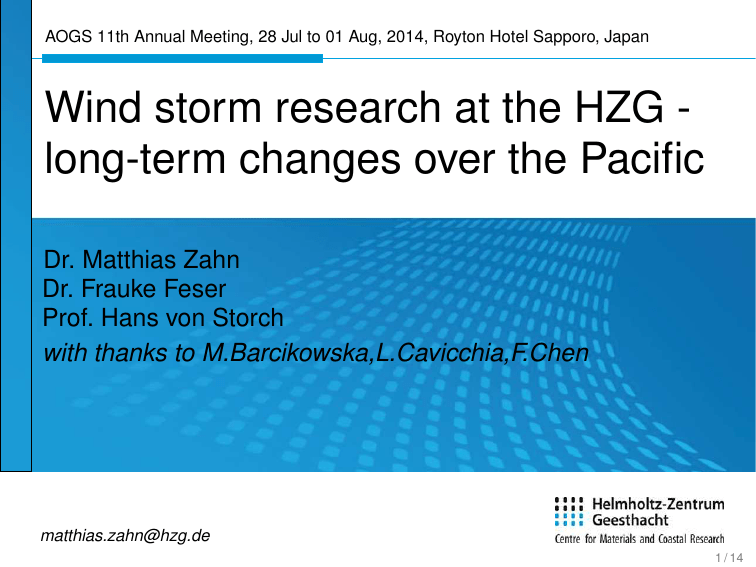
AOGS 11th Annual Meeting, 28 Jul to 01 Aug, 2014, Royton Hotel Sapporo, Japan Wind storm research at the HZG long-term changes over the Pacific Dr. Matthias Zahn Dr. Frauke Feser Prof. Hans von Storch with thanks to M.Barcikowska,L.Cavicchia,F.Chen matthias.zahn@hzg.de 1 / 14 Recently investigated phenomena Polar Lows (NA) Polar Lows (NP) c Dundee from Fu et al., 2004 Typhoons c NOAA Medicanes c NOAA/MSAT How do the occurrence frequencies of these phenomena change over time? Also at HZG: Extra-tropical Storms at centennial time scale: Lan Xia at 2.15pm 2 / 14 Research tools: numerical models low-res global-domain Simulation ◮ ◮ ◮ ❄ Detection ◮ high-res RCM-domain different atmosphere models dynamical downscaling decades of global data to RCM domain spectral nudging ◮ automated storm detection methods applied scale separation methods based 3 / 14 Simulation of Typhoon Songda CSFR CCLM-NN CCLM-SN from Barcikowska (2013) Figure 4.4 Horizontal surface wind speed fields [m s-1] for TC Songda, on 1st September 2004, 00:00. From left: CFSR reanalysis, CCLM-NN, CCLM-SN. For CCLM the first simulation (simulation no 10 and 20) of each ensemble is shaded, the other simulation are shown as contour lines: 10 [m s-1] as solid lines, 18 [m s-1] as dotted lines. Spectral nudging inhibits model variability 4 / 14 Detection of a Jan 1998 PL case Zahn et al., 2008, Tellus & & A #3*#*+3. ( // Simulation grid 5 )- ◮ 5 )- 6 & ◮ ◮ digital filter: 200 600km spatial scales are retained PL signal becomes more distinct used for detection 5 / 14 Past and future PL frequency Zahn and von Storch, 2010, Nature Number of PLs per winter in the past ◮ ◮ ◮ no change in past strong decrease under GHG warming atmosphere projected to become more stable Left: average PLs per IPCC scenario. Right: Area and time-averaged ice free SST − T500hPa over northern North Atlantic. 6 / 14 Past PL frequency, North Pacific Number of detected Polar Lows from Chen and v.Storch, 2013, Advances in Meteorology 1 250 0.8 200 0.6 150 0.4 100 0.2 50 1948/ 1949 1958/ 1959 1968/ 1969 1978/ 1979 PLS 1988/ 1989 locations of genesis ◮ ◮ ◮ 1998/ 1999 2008/ 2009 0 1948/ 1949 1958/ 1959 1968/ 1969 Detected Polar Low PDO 1978/ 1979 PLS 1988/ 1989 1998/ 1999 2008/ 2009 PNA ENSO NCEP downscaled to 50km over North Pacific upward, but no significant change link to NP circulation indices: CPNA = 0.45, CPDO = 0.39, CENSO = 0.22 7 / 14 Future PL frequency, North Pacific from Chen et al., 2014, Clim.Dyn. locations of genesis ◮ ◮ ◮ ◮ ◮ A1B - C20 frequency change of vdT > 39K , red/blue: less/more stable IPCC scenarios B1, A1B and A2 downscaled to 50km over North Pacific significant decrease decrease linked to GHG increase linked to a more stable atmosphere 8 / 14 Medicanes, Mediterranean Sea NCEP ° °10 W ° ° 5 W 0 ° 5 E ° 10 E ° 15 E from Cavicchia et al., 2013, Clim.Dyn. ° 20 E ° 25 E ° 30 E ° 35 E ° 40 E 6 50 N 5 ° 45 N 4 ° 40 N 3 ° 35 N 2 ° 30 N 1 ° 0 25 N 1950 locations of medicane genesis ◮ ◮ ◮ 1960 1970 1980 1990 2000 2010 number of medicanes per season downscaled to 10km (double nesting) rare phenomenon negligible change 40 E 9 / 14 Past typhoon frequency Barcikowska, in preparation a) b) c) d) black/red: all/most intense typhoons in CLM ◮ ◮ ◮ NCEP downscaled to 50km with CLM slight overall increase stronger increase of most intense typhoons Fig. 3. Trends for yearly occurrences of intense TC estimated with a linear regression using a least squares fit derived for every 5◦ x 5◦ grid box; for the period 1978-2001, for a) CCLM-NCEP, b) CCLM-ERA, c) JMA, d) JTWC. ◮ ◮ North: more activity South: less activity 25 10 / 14 Future typhoon frequency M. Barcikowska, pers. comm. detected typhoons in transient A1B scenario ◮ ◮ ◮ IPCC A1B downscaled to 50km with CLM different detection configurations decrease with warming 11 / 14 Current activity: global downscaling low-res global-domain ◮ ◮ ◮ ❄ ◮ ◮ ◮ apply a global ECHAM6 dynamical downscaling to global domain (M. Schubert-Frisius) spectral nudging enables direct storm studies linkages between different ocean basins possible high potential driving further models down the chain high-res global-domain 12 / 14 Summary At HZG, different types of storms: ◮ ◮ were reconstructed using RCMs will be simulated using global downscaling Storm activity changes: ◮ ◮ ◮ no significant past change of activity decreased activity in a warmed future decrease linked to more stable atmosphere 13 / 14 Thank you very much for your attention ご清聴ありがとうございました http://coast.hzg.de/staff/zahn/ 14 / 14
